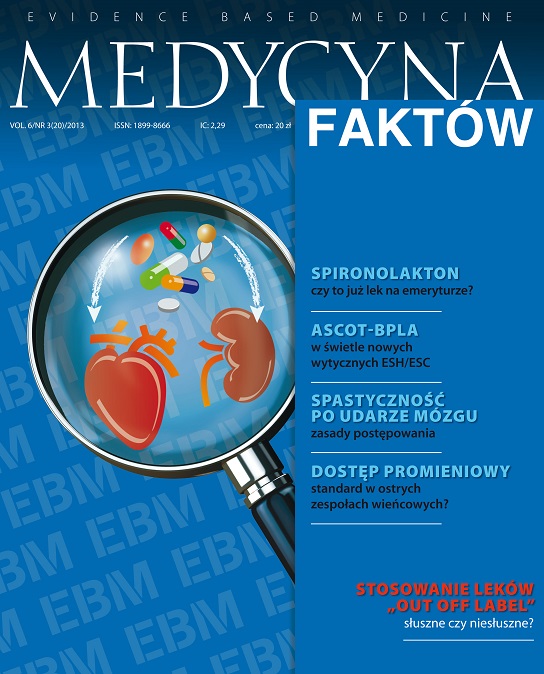Badanie the Anglo-Scandinavian Cardiac Outcomes Trial- -Blood Pressure Lowering Arm (ASCOT-BPLA) – interpretacja w świetle wyników nowych badań oraz nowych wytycznych ESH/ESC Artykuł przeglądowy
##plugins.themes.bootstrap3.article.main##
Abstrakt
Badanie the Anglo-Scandinavian Cardiac Outcomes Trial-Blood Pressure Lowering Arm (ASCOT-BPLA), w którym uczestniczyło 19 257 osób z nadciśnieniem tętniczym oraz co najmniej 3 innymi czynnikami ryzyka, wykazało przewagę leczenia opartego na amlodypinie i peryndoprylu nad leczeniem atenololem w połączeniu z bendroflumetiazydem. Wskazuje się na kilka przyczyn, które mogą tłumaczyć lepsze rokowanie pacjentów leczonych amlodypiną/peryndoprylem. Po pierwsze – leczenie przy użyciu amlodypiny/peryndoprylu było związane z nieco większym obniżeniem ciśnienia tętniczego mierzonego na tętnicy ramieniowej. Po drugie – zanotowano odmienny wpływ badanych leków na ryzyko rozwoju cukrzycy, stężenie lipidów i kreatyniny oraz na masę ciała. Trzecią przyczyną lepszego rokowania grupy leczonej amlodypiną i peryndoprylem może być korzystniejszy wpływ tych leków na ciśnienie centralne, a czwartą – większa zmienność ciśnienia tętniczego w grupie leczonej atenololem i diuretykiem.
##plugins.themes.bootstrap3.article.details##
Copyright © by Medical Education. All rights reserved.
Bibliografia
2. Corrao G., Parodi A., Zambon A. et al.: Reduced discontinuation of antihypertensive treatment by two-drug combination as first step. Evidence from daily life practice. J. Hypertens. 2010; 28: 1584-1590.
3. Wald D.S., Law M., Morris J.K. et al.: Combination therapy versus monotherapy in reducing blood pressure: meta-analysis on 11,000 participants from 42 trials. Am. J. Med. 2009; 122: 290-300.
4. Dahlöf B., Sever P.S., Poulter N.R. et al.: Prevention of cardiovascular events with an antihypertensive regimen of amlodipine adding perindopril as required versus atenolol adding bendroflumethiazide as required, in the Anglo-Scandinavian Cardiac Outcomes Trial-Blood Pressure Lowering Arm (ASCOT-BPLA): a multicentre randomised controlled trial. Lancet 2005; 366: 895-906.
5. Lewington S., Clarke R., Qizilbash N. et al.: Age-specific relevance of usual blood pressure to vascular mortality: a meta-analysis of individual data for one million adults in 61 prospective studies. Lancet 2002; 360: 1903-1913.
6. Poulter N.R., Wedel H., Dahlöf B. et al.: Role of blood pressure and other variables in the differential cardiovascular event rates noted in the Anglo- Scandinavian Cardiac Outcomes Trial-Blood Pressure Lowering Arm (ASCOT-BPLA). Lancet 2005; 366: 907-913.
7. Hamilton W.F., Woodbury R.A., Happer H.T.: Physiologic relationships between intrathoracic, intraspinal tind arterial pressures. JAMA 1936; 107: 853-856.
8. Wood E.H., Fuller J., Clagett O.T.: Intraluminal pressures recorded simultaneously from different arteries in man (abstract). Am. J. Physiol. 1951; 167: 838-839.
9. Jankowski P., Kawecka-Jaszcz K.: Centralne ciśnienie tętnicze. Via Medica, Gdańsk 2010.
10. Safar M.E., Blacher J., Protogerou A. et al.: Arterial stiffness and central hemodynamics in treated hypertensive subjects according to brachial blood pressure classification. J. Hypertens. 2008; 26: 130-137.
11. Safar M.E., Blacher J., Jankowski P.: Arterial stiffness, pulse pressure, and cardiovascular disease-is it possible to break the vicious circle? Atherosclerosis 2011; 218: 263-271.
12. Jankowski P., Bilo G., Kawecka-Jaszcz K.: The pulsatile component of blood pressure: its role in the pathogenesis of atherosclerosis. Blood Press. 2007; 16: 238-245.
13. Jankowski P., Kawecka-Jaszcz K., Czarnecka D. et al.: Ascending aortic, but not brachial blood pressure-derived indices are related to coronary atherosclerosis. Atherosclerosis 2004; 176: 151-5.
14. Safar M.E., Blacher J., Pannier B. et al.: Central pulse pressure and mortality in end-stage renal disease. Hypertension 2002; 39: 735-738.
15. Roman M.J., Devereux R.B., Kizer J.R. et al.: Central pressure more strongly relates to vascular disease and outcome than does brachial pressure: the Strong Heart Study. Hypertension 2007; 50: 197-203.
16. Jankowski P., Kawecka-Jaszcz K., Czarnecka D. et al.: Pulsatile but not steady component of blood pressure predicts cardiovascular events in coronary patients. Hypertension 2008; 51: 848-855.
17. Pini R., Cavallini M.C., Palmieri V. et al.: Central but not brachial blood pressure predicts cardiovascular events in an unselected geriatric population: the ICARe Dicomano Study. J. Am. Coll. Cardiol. 2008; 51: 2432-9.
18. Vlachopoulos C., Aznaouridis K., O’Rourke M.F. et al.: Prediction of cardiovascular events and all-cause mortality with central haemodynamics: a systematic review and meta-analysis. Eur. Heart J. 2010; 31: 1865-1871.
19. Wang K.L., Cheng H.M., Chuang S.Y. et al.: Central or peripheral systolic or pulse pressure: which best relates to target organs and future mortality? J. Hypertens. 2009; 27: 461-467.
20. Manisty C.H., Hughes A.D.: Meta-analysis of the comparative effects of different classes of antihypertensive agents on brachial and central systolic blood pressure, and augmentation index. Br. J. Clin. Pharmacol. 2013; 75: 79-92.
21. Williams B., Lacy P.S., Thom S.M. et al.: Differential impact of blood pressure-lowering drugs on central aortic pressure and clinical outcomes: principal results of the conduit artery function evaluation (CAFE) study. Circulation 2006; 113: 1213-1225.
22. Rothwell P.M., Howard S.C., Dolan E. et al.: Effects of beta blockers and calcium-channel blockers on within-individual variability in blood pressure and risk of stroke. Lancet Neurol. 2010; 9: 469-480.
23. Parati G., Ochoa J.E., Lombardi C. et al. Assessment and management of blood-pressure variability. Nat. Rev. Cardiol. 2013; 10: 143-155.
24. Wojciechowska W., Cwynar M., Gryglewska B. et al.: Analiza fali tętna: od podstaw do zastosowań. Przegl. Lek. 2002; 59(supl. 3): 9-14.
